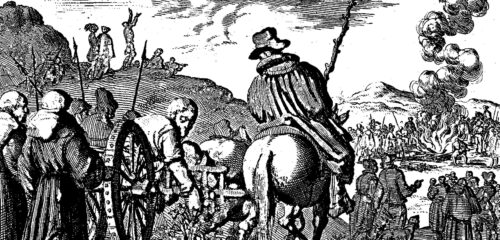-

Adventismus und Täuferbewegung
Internationales Symposium des Instituts für adventistische Geschichte und Theologie
Neue Perspektiven zu Adventismus und die Täuferbewegung: Symposium erfolgreich beendet
Das Symposium „Adventism and the Anabaptists“ (Adventismus und Täuferbewegung) hat wissenschaftliches Neuland betreten: Erstmals wurde diesem Thema eine internationale Tagung gewidmet. Vom 15. bis 18. April 2024 fand die Konferenz mit 16 renommierten Referenten an der Theologischen Hochschule Friedensau statt. Organisiert wurde sie vom Institut für adventistische Geschichte und Theologie, das damit bereits das fünfte Symposium dieser Art durchführte. Die Vortragenden kamen vor allem aus Deutschland und den USA sowie Dänemark, Italien, den Niederlanden, Russland und Tschechien.
Das Ergebnis des Symposiums ist, dass die Einflüsse täuferischer Kirchen auf Siebenten-Tags-Adventisten zwar indirekt, doch vielfältig und bemerkenswert sind. Adventisten stehen insbesondere den Mennoniten oft näher, als dies Vertretern beider Kirchen bewusst ist – sowohl im Hinblick auf Ethik und Lebensstil als auch in Bezug auf Bildungsverständnisse und kirchliches Leben sowie in vielen theologischen Überzeugungen. Durch ihre historischen Erfahrungen der Verfolgung und Vertreibung ernten täuferische Kirchen von Adventisten den größtmöglichen Respekt, zumal in manchen Regionen (historisch vor allem in Russland) viele Adventisten ursprünglich aus den Täuferkirchen stammten. Themen, bei denen die Freikirche der Siebenten-Tags-Adventisten aus der Geschichte der Täufer insbesondere lernen kann, sind das Engagement für den Frieden und der Einsatz für religiöse Freiheit durch die Bereitschaft zum Martyrium.
Die Vorträge werden in einem Tagungsband veröffentlicht, der noch 2024 erscheinen soll. Im Jahr 2025 erinnern Kirchen, die auf die Täuferbewegung des 16. Jahrhunderts zurückgehen oder ihre Prinzipien übernommen haben, an die Täufer und den Beginn ihrer Bewegung im Jahr 1525.
Das Institut für adventistische Geschichte und Theologie an der Theologischen Hochschule Friedensau dient der historischen und konfessionskundlichen Erforschung des Adventismus und der mit ihm verwandten Strömungen. Es ist die einzige wissenschaftliche Institution dieser Art in Europa.
Prof. Stefan Höschele, ThH Friedensau
 Presenters and Presentations
Presenters and Presentations
- Michal Balcar, Czech Republic
“Heirs of the Anabaptists? Seventh-day Adventists and Baptists and Their Attitudes towards Communist Regimes (a Case Study of the GDR and Czechoslovakia)“ - Lasse Bech, Denmark
“Suspicion and Indebtedness: A Study of Baptist and Adventist Mutual Conceptions of Each Other in Nineteenth-Century Denmark” - Reinder Bruinsma, Ph.D., Netherlands
“Anabaptist Roots in the Adventist Footwashing Praxis” - Rodgir Cohen, Ph.D., USA
“Seventh-day Adventists as a Peace Church?” - Romano Davide, Italy
Religious Liberty, Freedom of Faith, Freedom of Life. A Possible Political Theology for Adventism” - Johannes Hartlapp, Dr. phil., Germany
“Election and Eschatology in Thomas Müntzer and Hans Huth” - Stefan Höschele, Ph.D., Germany
“Adventist Darlings: SDA Interchurch Sentiments and the Anabaptist Exceptionalism” - Cédric Lachenal, Ph.D., Belgium / Madagascar
“Anabaptist Hymnody: Key Hymns that Have Impacted Early SDA Hymnody” - Bernd Müller, Dr. phil., Germany
“Concepts of Education among the Anabaptists and in Adventism” - Rolf Pöhler, Th.D., Germany
“The Schleitheim Confession: An Adventist Perspective” - Johannes Reimer, Ph.D., Germany
“Mennonites and Adventists in Russia: Early Relationships and Cross-Fertilisation” - Martin Rothkegel, Th.D., Dr. phil., Germany
[Topic still to be supplied] - Charles Scriven, Ph.D., USA
“Christian Citizenship and the Path to Human Wholeness: Toward a Pastoral Theology of Peacemaking” - Gilbert Valentine, Ph.D., USA
“Ellen White and the Anabaptist Movement” - Astrid von Schlachta, Dr. phil., Germany
Opening Lecture - Eugene Zaitsev, Ph.D., Russia
“The Role of Mennonites in Preparing the Way for Planting the SDA Church in Russia”
 Background
Background
On the evening of January 21, 1525, Konrad Grebel baptised the former Roman Catholic priest Jörg Blaurock, who had asked him to do so, in Zollikon, near Zurich. Blaurock then baptised others among their friends. With this act, a first independent congregation was constituted which detached itself from the Zurich Reformation. To this day, January 21, 1525, is considered the founding date of a movement that has been pejoratively named the “Wiedertäufer” (Anabaptist) movement by its opponents. Since the 20th century, it has also been called the Radical Reformation or the “left wing” of the Reformation. Yet these names can only inadequately reflect the breadth and diversity of interests of the movement. The core concern was the longing for a comprehensive Reformation, which was dominated by four emphases: (1) consistent discipleship, (2) the Holy Scriptures as the indispensable standard for faith and life, (3) the priesthood of all believers, and (4) the separation of church and state power. This often led to strict non-violence, withdrawal from the world and strong eschatological expectations. Faith baptism marked membership in the movement.
The Anabaptists did not represent a homogeneous revival movement within the 16th century Reformation and was not limited to Switzerland and Southern Germany. The radical demands prominent among them, i.e. church-state separation and the personal decision for the faith by each Christian, represented a significant intellectual-historical background for the Reformation which had been initiated by Martin Luther and Huldrych Zwingli. For various reasons, however, these two categorically rejected the claims of the Anabaptist movement, and even demanded and supported their persecution by the authorities. As early as 1527, the Anabaptist leader Felix Manz was drowned in the Limmat river of Zurich, and Michael Sattler was burned in Rottenburg am Neckar. Two years later, in 1529, the Diet of Speyer passed the so-called “Anabaptists Mandate” with the consenting votes of the Protestant princes. This resolution stipulated that all those who practised faith baptism and those who did not have their children baptised were to be sentenced to death. Although the mandate was not implemented in the same manner everywhere, many Anabaptists lost their lives because of their faith.
Even though today there are only a few major groups that directly trace their history back to the Anabaptist movement (the Mennonites, the Amish, and a few others), influences of this movement can be found in many ways in the creeds and church order of contemporary denominations. In preparing for the 500th anniversary of the Anabaptist movement in 1525, Friedensau Adventist University invites you to an international symposium that explores various aspects and vestiges of the Anabaptist movement in Adventism and beyond.